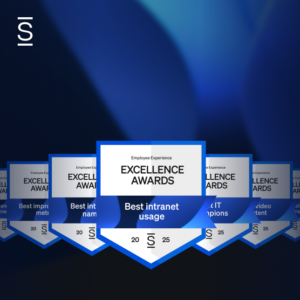Employee advocacy happens when employees talk or post positively about their company or its products and services—and their praise is just naturally promotional. A purposeful employee advocacy strategy helps facilitate the creation and distribution of this praise, combining it with targeted, quality content that amplifies company awareness and market perception.
Why an employee advocacy strategy is genius
When looking for advice or recommendations, people tend to trust their peers more than they trust a company or CEO message. For this reason, a tailored employee advocacy strategy is a smart move. Without one, companies are lost in an ocean where thousands of brands are treading water and grasping for visibility from various channel participants.
But suppose your employees connect with their social media friends and followers with authentic, personal communications about the company’s products and services. In that case, this will have a greater reach than any advertising campaign. And with a fine-tuned strategy, these messages will set your brand apart in the most natural and viral way possible.

The benefits of an employee advocacy strategy
There are many benefits of an employee advocacy strategy, including:
- Increased recognition and visibility. The more people talk about a brand to friends, family, and acquaintances, the more familiar, trustworthy, and visible it becomes.
- Improved brand reputation. When people share positive, personal messages about a brand, it earns a much stronger reputation than mere advertising can provide, and brand loyalty is strengthened too.
- More sales opportunities. When everyone is talking about a brand and wanting that specific product or service, it follows that sales will increase as new audiences discover you and new sales channels open.
- Amplified employee engagement and morale. Employees working for a successful, well-respected, reliable brand will be loyal and experience higher morale than those working for a less attractive brand.
- Better online engagement. A successful brand will experience more website visits and higher search engine rankings.
- Decreased marketing costs. When employees are engaged and send personal, memorable messages about the company’s brand, this takes the pressure off the marketing department and lowers advertising costs.
- Customer advocacy. When employees share great stories, customers will carry the message further and become valued brand ambassadors themselves.
- Attracting talent and employee retention. Top talent will be attracted to a popular, successful brand, and star performers are more likely to remain with a company that has a strong reputation.
So, how does one build a successful employee advocacy strategy?
How to build a successful employee advocacy strategy
We know now that when quality information is easy to share in a natural way, the benefits to brands are considerable. And that same thinking is at the heart of employee advocacy programs. We have some steps to follow below to help you along!
1. Know your goals and objectives
Think about your goals in relation to the company’s mission and what you want to achieve.
In the marketing area, maybe you want to engage your target audience and grow brand awareness. Think through the metrics you’ll need to track and how to best benchmark from the beginning. Increasing your followers is great, but if they’re not engaged and ultimately not buying, that doesn’t mean much.
And with sales, you’ll seek to identify new prospects, retain customers, and offer some upsell options that resonate—but which options, specifically?
Where recruiting is concerned, consider attracting top talent from various professional organizations, for example. And if you want to be more inclusive (which you shoud be), ensure that’s part of your planning.

2. Identify who will help you achieve these goals
Identify individuals, teams, or departments you will need to achieve the goals you’ve identified for your employee advocacy program. To start, focus on employees already familiar with and active on social media channels.
Obviously, it’s great if every employee is involved. This is something you can build toward by including more people as your program grows.
Leadership must be on board with the program because leading by example will encourage employees to invest time and effort and to understand why the program is a priority.
3. Clarify the value of an advocacy strategy to employees
Employees will need to know why it’s important to share regular content about the brand. Share the expected impact, both to the company and for personnel.
Sharing quality content increases the visibility of both the brand and the sharer, and employees can showcase their expertise and become thought leaders in the sector. Personal networks can also grow quickly. Sharing awareness around product, sales, and growth positively impacts the brand, driving an improved employee experience and morale.
4. Select the target audience
An employee advocacy strategy isn’t a one-size-fits-all technique for spreading the word about your brand. Individuals, teams, or departments must know where to direct their specific messages for maximum impact.
Target audiences can include current and prospective customers, as well as industry influencers, employees, and prospective employees.
Targeting relevant content to specific stakeholders encourages more consistent content sharing. When employees are engaged in this sharing, greater customer engagement occurs. And this results in improved customer experience and increased interest from future customers and employees.
5. Design relevant, quality content
You’ve identified customer audiences and the employees, groups, and channels best suited to share brand information. And now, you want to be sure that the content you’re communicating will resonate with its intended audiences.
Take time to consider, define and create the messages and tone you want to convey. Ensure they align with audience tastes, brand image and promise, and the specific sector you’re targeting. Keep these indicators unique to your brand and avoid repetition at all costs or else content will develop a stale vibe.
Make this content available to users in a central area, like on anintranet, so they can share information easily. Be aware that you will need consistent content from the beginning and will want to frontload your resources to be prepared. Do not be too general because niche content relating to the brand can also have extensive reach.
6. Decide which channels to use
The selection of channels depends on what communication systems you already have in place and how familiar employees are with these. You’ll also want to consider the weight of your content and how it balances with the message you wish to convey, your brand image and reputation, and your target audience.
For example, a short, to-the-point, text-rich message is better suited to an audience on Twitter, while a more light-hearted visual item could fare better on Instagram. Short videos are, of course, best for TikTok or Reels. Start with the channels you have, like, emails, town hall events, and others, and expand your curated content pile as you progress.
And bear in mind, mobile users generally find it easier and quicker to share content compared to those who are not mobile savvy.
7. Launch your program
As mentioned already, start with the channels you already use, post consistent, targeted, relevant content, and build from there according to feedback and suggestions from users. Ensure you have buy-in from leadership so employees know they have top-down support and are operating in an equal system.

8. Keep employees engaged
High levels of employee engagement are needed to create and sustain enthusiasm and passion regarding authentic company messaging. In addition, employees need to be motivated to regularly share content. Tactful reminders will help people remain engaged.
Share these reminders along with information about any successes resulting from the program. Get leadership on board and give them relevant content to share to encourage ongoing organizational participation.
Recognize employees who are exceptional participants or those with high engagement rates and reward them for it! Please don’t make it all about incentives, though, or the authenticity of employee participation could be lost.
9. Monitor progress and measure results
Regularly monitor results so changes and adjustments happen quickly and do not disrupt newly developing processes and relationships. Encourage feedback from participants and be open to new ideas and suggestions.
10. Training
Not everyone is familiar with social media sharing, following, liking, commenting, hashtags, and all the tips and tricks that go with each individual communications platform. Some training across the organization will be necessary. Some tips:
- Ensure the training is inclusive and easy to understand for less tech-minded people.
- Create and clearly post guidelines and boundaries for sharing content externally.
- Do not make the guidelines too restrictive; enthusiasm will wane, and messaging won’t feel authentic.
- Include tips for engaging positively with social media followers.
- Suggest ways to measure the individual success of advocacy efforts to get people excited about their achievements.
- Encourage further participation by offering incentives for active engagement, recognition, and rewards for top players.
Examples of successful employee advocacy programs
When people get together, the conversation inevitably turns to work and how everyone is getting on in their current job. If a person is passionate and enthusiastic about what they do and the company they work for, what better advocate for a brand could there be?
If that same person shares content about work on social media with friends, followers, customers, and the world at large, it makes sense to give them access to consistent, curated content around the brand to share. If someone, anyone, notices, hears, and understands the stories around the brand, then you have distinguished yourself from the rest.
What are some examples of successful advocacy programs doing just that? Here are a few:
- In this case study, you can find out how Iskraemeco, a company offering products, services, and solutions to support energy and water efficiency systems, used an employee advocacy strategy as part of its marketing initiative to strengthen its brand, increase awareness of new services, attract new employees, and gain followers.
- You can also read here about how top companies Edelman, Kelly Services and Hewlett-Packard enjoyed success after implementing employee advocacy strategies.
- Other companies using effective employee advocacy strategies include Dell, Adobe, Starbucks, Reebok, EA games, Vodafone, Humano, Bluwolf, Master Card and more.
The best employee advocacy strategy is an ongoing process. It’s best kept simple with clear goals and objectives and a strategy that revolves around achieving them.
Word of mouth is the most powerful, significant, trusted voice in the marketplace today. Influential brand ambassadors exist right now in your workforce, so be sure to harness that resource with an effective employee advocacy strategy. Reach out for a demo of our employee experience platform, and we’ll show you how!


















